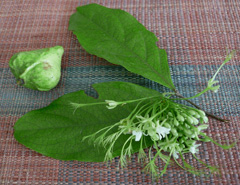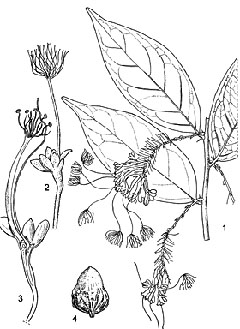 |
|
https://edibleplants.org/ |
 |
| https://edibleplants.org/ |
Translate this page:
Summary
Monkey Fruit (Dactyladenia barteri) can be a climbing shrub or a small tree of up to 12 m tall with a dense and spreading crown. Its trunk is crooked and fluted, up to 40 cm in diameter. It is usually found in western tropical Africa. The plant has an extensive, deep root system making it ideal for soil erosion control. The bark and roots are used medicinally to treat a wide range of ailments. The wood can be used as poles and for constructions and fuel. It is resistant to termites, hard, and durable.
Physical Characteristics

 Dactyladenia barteri is an evergreen Tree growing to 10 m (32ft) by 10 m (32ft) at a medium rate.
Dactyladenia barteri is an evergreen Tree growing to 10 m (32ft) by 10 m (32ft) at a medium rate.
See above for USDA hardiness. It is hardy to UK zone 10. The flowers are pollinated by Red ants, Bees, Wasps.
It can fix Nitrogen.
It is noted for attracting wildlife.
Suitable for: light (sandy), medium (loamy) and heavy (clay) soils and can grow in nutritionally poor soil. Suitable pH: mildly acid, neutral and basic (mildly alkaline) soils and can grow in very acid soils.
It cannot grow in the shade. It prefers moist soil.
UK Hardiness Map
US Hardiness Map
Synonyms
Acioa barteri (Hook.f. ex Oliv.) Engl. Acioa lanceolata Engl. Acioa tenuiflora Dinkl. & Engl. Griffo
Plant Habitats
Edible Uses
References More on Edible Uses
Medicinal Uses
Plants For A Future can not take any responsibility for any adverse effects from the use of plants. Always seek advice from a professional before using a plant medicinally.
Purgative
The bark and roots are used medicinally as a purgative and against a variety of ailments[ 303 ].
References More on Medicinal Uses
The Bookshop: Edible Plant Books
Our Latest books on Perennial Plants For Food Forests and Permaculture Gardens in paperback or digital formats.

Edible Tropical Plants
Food Forest Plants for Hotter Conditions: 250+ Plants For Tropical Food Forests & Permaculture Gardens.
More

Edible Temperate Plants
Plants for Your Food Forest: 500 Plants for Temperate Food Forests & Permaculture Gardens.
More

More Books
PFAF have eight books available in paperback and digital formats. Browse the shop for more information.
Shop Now
Other Uses
Fuel Hedge Mulch Plant support Soil conditioner Soil reclamation Soil stabilization Wood
Agroforestry Uses: The shrubs have an extensive, deep root system that holds the soil and so can be used in schemes to prevent soil erosion[ 303 , 310 ]. The tree produces large amounts of litter and recycles appreciable quantities of nutrients through its deep root system, whilst its dense canopy aids in weed suppression[ 303 ]. It has shown promise as mulch and soil regenerator because of its slow decomposition rate[ 299 , 303 ]. The stems provide good quality poles for staking yams and for construction[ 303 ]. The tree is planted in hedgerows in a traditional alley cropping system with inter-hedgerow spacing of 2 - 3 metres and with 1 - 2 years of cropping followed by 3 - 4 years of fallow. Following the fallow period, the shrubs are underbrushed and burned and stems cut to a height of 10 - 20cm. Some stems are left uncut for live staking of Guinea yam (Dioscorea cayenensis). Crops are then interplanted in the alleys[ 299 ]. Other Uses: The dark red wood is hard, durable and resistant to termite attack[ 299 , 303 ]. The stems provide good quality poles for staking crops and are also used for construction work[ 303 ]. The wood is used for fuel[ 299 ].
Special Uses
Attracts Wildlife Hedge Nitrogen Fixer
References More on Other Uses
Cultivation details
A plant of the moist, lowland tropics, being found at elevations below 300 metres[ 303 ]. It grows in areas where the mean annual temperature is in the range 20 - 34°c, and the mean annual rainfall is 750 - 1,500 mm[ 303 ]. Well adapted to leached, acid and infertile (ultisols) soils, the plant can also survive occasional flooding[ 303 ]. Established trees coppice well, even after pollarding or burning, and are fire resistant[ 99 , 303 ]. Planted at 4 metres x 4metres, this species can produce 6 tonnes per hectare dry prunings, 4 tonnes of twigs and 9 tonnes of wood within 8 months[ 303 ]. It has been suggested that Dactyladenia lehmbachii and Dactyladenia pallescens, which flower in the same period, may cross-pollinate with this species[ 299 ].
References Carbon Farming Information and Carbon Sequestration Information
Temperature Converter
Type a value in the Celsius field to convert the value to Fahrenheit:
Fahrenheit:
The PFAF Bookshop
Plants For A Future have a number of books available in paperback and digital form. Book titles include Edible Plants, Edible Perennials, Edible Trees,Edible Shrubs, Woodland Gardening, and Temperate Food Forest Plants. Our new book is Food Forest Plants For Hotter Conditions (Tropical and Sub-Tropical).
Shop Now
Plant Propagation
Seed - germinates readily[ 303 ]. Direct sowing is possible but seedlings survive better when raised in nursery bags before planting out[ 303 ]. Seed germinates readily and can be stored for up to 6 months at 15°c when treated with copper sulphate[ 303 ]. Occasionally, stakes are used as cuttings in live fence systems[ 303 ]. Juvenile stem cuttings will also root quickly at the peak of the rainy season[ 299 ].
Other Names
If available other names are mentioned here
Native Range
AFRICA: Cameroon, Democratic Republic of the Congo, Gabon, Benin, Côte D‘Ivoire, Ghana, Guinea, Liberia, Nigeria, Sierra Leone, Togo
Weed Potential
Right plant wrong place. We are currently updating this section.
Please note that a plant may be invasive in one area but may not in your area so it's worth checking.
Conservation Status
IUCN Red List of Threatened Plants Status : This taxon has not yet been assessed

Growth: S = slow M = medium F = fast. Soil: L = light (sandy) M = medium H = heavy (clay). pH: A = acid N = neutral B = basic (alkaline). Shade: F = full shade S = semi-shade N = no shade. Moisture: D = dry M = Moist We = wet Wa = water.
Now available:
Food Forest Plants for Mediterranean Conditions
350+ Perennial Plants For Mediterranean and Drier Food Forests and Permaculture Gardens.
[Paperback and eBook]
This is the third in Plants For A Future's series of plant guides for food forests tailored to
specific climate zones. Following volumes on temperate and tropical ecosystems, this book focuses
on species suited to Mediterranean conditions—regions with hot, dry summers and cool, wet winters,
often facing the added challenge of climate change.
Read More
Expert comment
Author
(Hook.f. ex Oliv.) Prance & F.White
Botanical References
Links / References
For a list of references used on this page please go here
A special thanks to Ken Fern for some of the information used on this page.
Readers comment
| Add a comment |
|
If you have important information about this plant that may help other users please add a comment or link below. Only comments or links that are felt to be directly relevant to a plant will be included. If you think a comment/link or information contained on this page is inaccurate or misleading we would welcome your feedback at [email protected]. If you have questions about a plant please use the Forum on this website as we do not have the resources to answer questions ourselves.
* Please note: the comments by website users are not necessarily those held by PFAF and may give misleading or inaccurate information.
To leave a comment please Register or login here All comments need to be approved so will not appear immediately.
|
Subject : Dactyladenia barteri
|
|
|
|